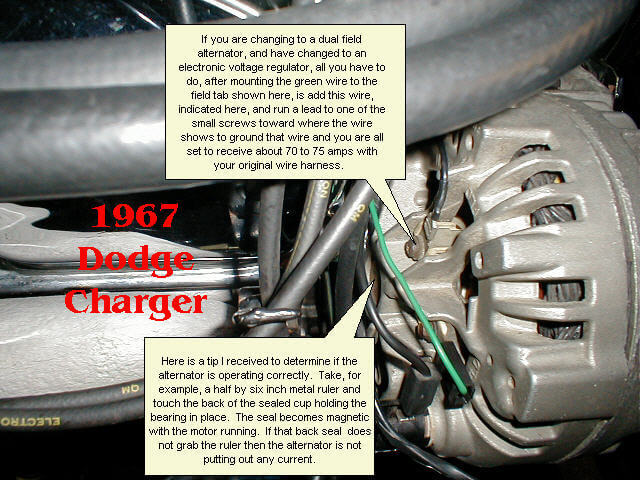66-67 Dodge Charger Source Guide
Alternator
| Posted by David
Walker on 07/07/03
John Paseman sells a dual field alternator replacement kit. It upgrades the original style 37 amp single field/mechanical regulator setup to the later model (70 up) 60 amp dual field alternator and a new Mopar performance electronic regulator. Includes the alternator, regulator, wiring harness and bracket so it is a 100% bolt-in. No drilling holes, cutting or splicing - total plug and play. You could even remove it in the future and go back to stock. The kit is complete with everything you need and is $149.96. It works exactly as advertised! A great addition to
daily-driven Chargers. From John: 10/12/07 In pre-70 (69 down) Mopar charging systems, the alternator field was "energized" by varying the positive side of the the field wiring circuit. The voltage regulator is doing the "varying" depending on the demand seen. After you start your car, the battery will be low, voltage of the system will be a bit lower and the regulator will increase the voltage to the field circuit in the alternator. The field circuit is "energized" and cause the alternator to output more current. Early Mopars varied the positive side only, the negative side is grounded inside the alternator. This is why early alternators are referred to as "single field" - it really is they only have one connection to the field brought to the outside of the alternator. They still have two, the second is grounded inside the alternator. Take one apart - you'll find the field wire attached to the case (ground). In the early system wiring harness, the single "field" wire is green. In 1970 and later Mopar charging systems, the voltage regulator was changed to control the ground (negative) side of the field circuit. This had to do with the state of the art in electronics at the time and it was easier and more efficient to control the ground side using electronics than it would have been to control the positive side. To make that work, one field wire to the alternator now is nominal system voltage (roughly 12v) all the time. The other wire (in the early systems, was grounded inside the alternator) is now brought back to the voltage regulator which varies the ground side of the circuit. Since the charging system now needs two wires to the alternator, both field connections where brought to the outside of the alternator - this is where the popular phrase "Dual Field" alternator came from. It is not really Dual fields, it is dual connections to the single field. In that sense, the early and late alternators are almost identical in design and performance. In the late system wiring harness, the two field wires are both green and can be reversed at the alternator - it doesn't matter which side is connected to the 12v and which is connected to the grounded (via the regulator) side. Changes in rotor, stator, diode and wiring technology allowed for an increase in performance (higher amp output) in the later dual connection alternator design and coupled with the electronic regulator (in place of the earlier mechanical points regulator) made the charging system more robust. Graphic posted by Marc Milosovich on 09/22/06 
|
| Check out the Allpar Website for good alternator information. |